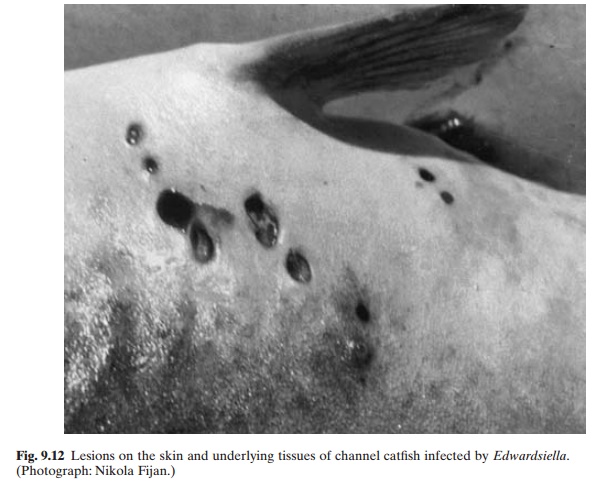Chapter: Aquaculture Principles and Practices: Health and Diseases
Edwardsiellosis - Bacterial diseases of aquaculture species
Edwardsiellosis
Edwardsiellosis, caused by infection by Edwardsiella tarda, affects Ictalurids, Cyprinidsand Anguillidae in the southern USA and Southeast Asia. It causes gas-filled lesions in the muscle tissues of mature fish. In the initial stages of the infection and in mild infections, small cutaneous lesions (of 3–5 mm diameter) can be observed on the flanks (fig. 9.12) and caudal peduncle of the fish. Mortality seldom exceeds 5 per cent in affected channel catfish in ponds, but may reach 50 per cent or more if the fish are transferred to holding tanks.

Colonies of E. tarda are dirty grey in colour and smooth. The organism is motile, gram-negative and fermentative. It occurs in organically polluted waters. Lesions develop in the infected fish 10–15 days after exposure, becoming large gas-filled cavities containing necrotic tissue. Bacteria can frequently be detected in the blood or kidney of the fish and evidently cause disfunction of the organs. Infection by E. tarda may often occur in association with Aeromonas or Pseudomonas infections and therefore confusion can arise in diagnosis. Recovery from the disease is rather slow. Prevention of the disease has to be attempted through avoidance of environmental stresses, improved husbandry practices and better nutrition. Treatment with antibacterials is reported to be effective. Oxyte-tracycline (terramycin) in the diet at the rate of 2.5 g per 45 kg fish per day for 10–12 days is the recommended dosage. Sulphonamide or furacin have also been reported to be effective.
Related Topics